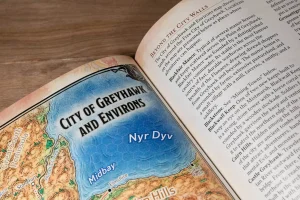Official Review
The 2014 release of the 5th edition Dungeon Master's Guide came at a crucial time for Wizards of the Coast. Dungeons & Dragons' 4th edition had been struggling to expand its player base for years, leading many to question if the iconic tabletop role-playing game could maintain its waning relevance. As it turned out, the 5th edition was a success, and D&D is now more popular than ever in its over 50-year history. This is partly due to its solid game mechanics, but also thanks to a thriving actual play community that constantly raises the bar for performance and storytelling.
Wizards is now making another attempt to refresh the D&D brand with a revised, updated, and expanded 5th edition Dungeon Master's Guide (2024). I'm pleased to report that it seems to be exactly what the game and its fans need right now. The developers could have simply followed the community's lead, formalizing the way the modern game is played and the culture around it. While they've done that to a large extent, the book also pushes the game forward in significant ways, adding exciting new tweaks to an already successful formula. The DMG feels both essential and inspiring, making it an excellent way to start D&D's next half-century.
The improvements and additions to the DMG (2014) are evident from the start. Instead of 70 pages of intensive world-building and cosmology, the DMG (2024) begins with some gentle guidance — including a substantial section on comfort and safety at the gaming table. To use a phrase from the late Carl Sagan, rather than creating a world from scratch, it focuses on perfecting that apple pie. At just under 20 pages, every slice is satisfying.
The book's curation efforts shine through its visual elements. Kate Irwin, the lead art director, and Josh Herman, Wizards' head of art, have breathed new life into the DMG's look. They've added numerous carefully chosen new pieces that showcase the wide range of experiences from past adventures. These visuals inspire readers to explore the game's rich history without pushing them towards any specific setting. The book is filled with striking, full-page artwork packed with Easter eggs and inside jokes, detailed depictions of weapons and magical items, and highly useful general-purpose maps at the back. All these elements work together with the layout and graphic design to create a visually appealing framework that's both practical and memorable.
But it's not just about the visuals. The DMG (2024) truly stands out in how it equips Dungeon Masters with the tools and inspiration to create their own worlds and campaigns. The middle chapters - "DM's Toolbox," "Creating Adventures," and "Creating Campaigns" - are more logically arranged and clearly presented than in the previous version. This improved organization, along with the wealth of random tables in each chapter, makes the DMG (2024) much more useful for DMs on a session-by-session basis. It's now a resource that can help you out of a tight spot with a clever puzzle or an inquisitive NPC, rather than just a rulebook that's only pulled out occasionally for the group's rules expert.
The book's usefulness extends even further. The DMG (2024) is 60 pages longer than its 2014 counterpart, though some pages are more valuable than others.
One particularly useful addition is the mini-book on Greyhawk, one of D&D's earliest fictional settings from the 1970s. This nearly 30-page section serves as a step-by-step guide for DMs looking to build their own world from scratch. Combined with the 15 pages of generic maps and the double-sided color poster map, this section provides a solid foundation for players to build their first campaign. It's a great addition to the guide and will be incredibly helpful for newcomers in the years to come.
While the book excels in many areas, the section on bastions falls short. These player-owned fortresses, available from level five, aim to give players more agency in the world. However, this fantasy real estate concept feels out of place. The section is tedious and doesn't match the book's overall tone. It's more like a mix of optional rules and a design document for a D&D-themed life simulation game. Fortunately, it's easy to overlook.
Now, let's talk about the digital aspects of the DMG (2024). Like the Player's Handbook (2024), this content is available through D&D Beyond with a revocable license, at a lower price than the physical book.
However, the digital platform's key features - the map function and encounter builder - are still in beta. Add to this a mix of "legacy" and current rules, and you get a confusing online environment that's tough for newcomers. Given these issues, I suggest getting the physical book instead. While digital character sheets and linked spellbooks are nice, a physical book offers lasting value in our ever-changing digital world.




